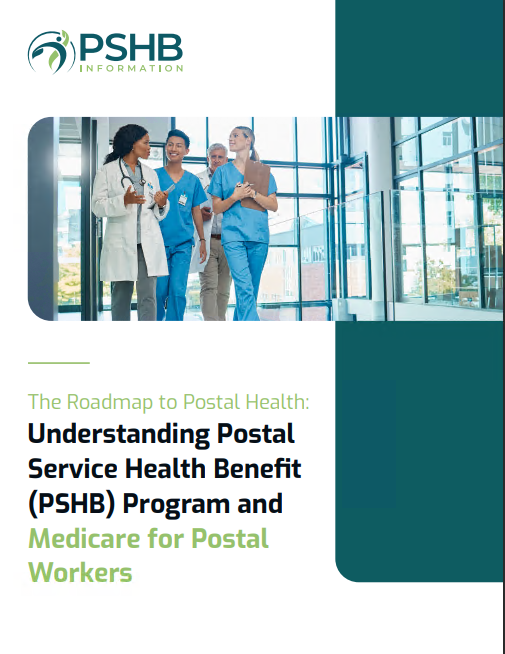Key Takeaways
-
The Postal Service Health Benefits (PSHB) program introduces tailored health coverage exclusively for postal workers and retirees, offering a different structure compared to the Federal Employees Health Benefits (FEHB) program.
-
While FEHB has historically covered a broad range of federal employees, PSHB focuses specifically on postal workers, with distinct costs, coverage options, and Medicare integration rules.
Breaking Down the Basics: PSHB vs. FEHB
If you’re navigating your health coverage options in 2025, the Postal Service Health Benefits (PSHB) program and the Federal Employees Health Benefits (FEHB) program may seem similar at first glance. But as a postal employee or retiree, the PSHB program is now your primary option. To understand what sets these two programs apart, let’s explore their structure, costs, and coverage.
What is the PSHB Program?
PSHB was introduced as a part of the 2022 Postal Service Reform Act and became effective on January 1, 2025. It is tailored exclusively for Postal Service employees, annuitants, and their eligible family members. The primary aim of PSHB is to separate postal workers from the broader FEHB pool, creating a program that better addresses the unique needs of postal employees. It provides a variety of plan options that offer comprehensive medical, dental, and prescription coverage. Additionally, PSHB coordinates with Medicare for retirees who are eligible.
What is the FEHB Program?
FEHB has long been the gold standard for federal employee health insurance. Covering millions of current and former federal employees and their families, it offers extensive plan options across the country. FEHB operates on a shared premium structure, where both the employee and the federal government contribute to the cost. While the PSHB program retains some structural similarities to FEHB, its focus is exclusively on postal workers.
Comparing Coverage Options
1. Available Plans
-
PSHB Plans: The PSHB program offers health insurance plans tailored specifically for postal employees, including options for those with Medicare Part B. While many plans resemble their FEHB counterparts, some plan designs and cost-sharing arrangements have been adjusted to better suit the postal workforce.
-
FEHB Plans: FEHB provides a broader selection of plans, covering various federal employee groups, including high-deductible plans, HMOs, and PPOs. Since FEHB caters to a larger population, the variety is more extensive than PSHB.
2. Prescription Drug Coverage
-
PSHB: All PSHB plans include integrated prescription drug coverage, which automatically enrolls Medicare-eligible retirees and family members into a Medicare Part D Employer Group Waiver Plan (EGWP). This provides significant savings on medication for those with Medicare.
-
FEHB: FEHB also offers prescription coverage, but it’s not tied to a specific Medicare Part D program. Retirees may need to explore their coordination options independently.
3. Supplemental Benefits
-
PSHB: Like FEHB, PSHB plans often include supplemental benefits such as dental, vision, and wellness programs. These benefits are designed to support the health needs of postal workers and their families.
-
FEHB: Supplemental benefits under FEHB are generally more varied, as they cater to a wider range of federal employees with different needs.
Key Cost Differences
When it comes to costs, PSHB and FEHB share similarities, but there are notable differences in premiums, deductibles, and out-of-pocket expenses.
1. Premiums and Contributions
-
PSHB: The government covers approximately 70% of the total premium costs, leaving employees and retirees to pay the remaining portion. Premium amounts vary by plan type (Self Only, Self Plus One, or Self and Family). For Medicare-eligible retirees, some plans offer premium reimbursement incentives for Medicare Part B enrollment.
-
FEHB: FEHB also follows the 70% government contribution model. However, because FEHB encompasses a larger and more diverse group of enrollees, premiums may vary more widely than in PSHB.
2. Deductibles and Coinsurance
-
PSHB: Deductibles and coinsurance amounts under PSHB plans are designed to balance affordability with coverage. For example, in-network deductibles may range from $350 to $500 for lower-deductible plans and higher for high-deductible options.
-
FEHB: Deductible ranges under FEHB are generally broader due to the diversity of available plans. Low-deductible plans may offer similar structures to PSHB, while high-deductible plans cater to those seeking Health Savings Account (HSA) compatibility.
3. Out-of-Pocket Maximums
-
PSHB: The in-network out-of-pocket maximum for PSHB plans is $7,500 for Self Only and $15,000 for Self Plus One and Family coverage.
-
FEHB: FEHB plans typically feature comparable out-of-pocket maximums, but there’s greater variability across plan types and carriers.
Medicare Integration: A Defining Feature
One of the standout differences between PSHB and FEHB is how the two programs integrate with Medicare. If you’re a Postal Service retiree, this distinction could have a significant impact on your healthcare decisions.
1. PSHB and Medicare
Starting in 2025, most Medicare-eligible postal retirees and their family members must enroll in Medicare Part B to maintain PSHB coverage. PSHB plans are specifically designed to work alongside Medicare, offering benefits like reduced deductibles, lower copayments, and premium reimbursements for enrollees who carry both PSHB and Medicare coverage. This alignment aims to reduce overall healthcare costs for retirees.
2. FEHB and Medicare
FEHB does not mandate Medicare enrollment for retirees, though it’s highly encouraged. Retirees who choose to enroll in Medicare Parts A and B often benefit from reduced out-of-pocket expenses. However, FEHB plans are not universally optimized for Medicare integration in the same way as PSHB plans.
3. Prescription Drug Benefits
PSHB’s integration with Medicare Part D through an Employer Group Waiver Plan is a key differentiator. This automatic enrollment ensures that retirees have seamless access to affordable prescriptions. In contrast, FEHB retirees must enroll in Medicare Part D separately if they wish to gain prescription drug savings.
Open Season: Your Window to Make Changes
Both PSHB and FEHB require enrollees to make changes during Open Season, typically held in November and December each year. For PSHB enrollees, this is an opportunity to review plan options and ensure your chosen coverage aligns with your health needs and budget. FEHB follows the same timeline, allowing federal employees to switch plans or adjust their coverage as necessary.
In 2025, PSHB Open Season runs from November 11 to December 13. Changes made during this period take effect on January 1, 2026. Be sure to review your options carefully, especially if your healthcare needs or Medicare status have changed.
Which Program is Right for You?
Ultimately, the decision between PSHB and FEHB isn’t one you’ll need to make if you’re a postal worker or retiree, as the PSHB program is now mandatory. However, understanding how PSHB differs from FEHB can help you make informed decisions about your healthcare. If you’re transitioning from FEHB to PSHB, consider these factors:
1. Evaluate Costs
Assess your plan’s premiums, deductibles, and out-of-pocket maximums to ensure affordability. If you’re eligible for Medicare, remember to factor in the cost of Part B premiums.
2. Review Plan Coverage
Look for plans that offer the benefits most important to you, such as dental, vision, or expanded prescription drug coverage. Don’t forget to compare network availability, especially if you’ve moved or anticipate changing healthcare providers.
3. Take Advantage of Medicare Integration
If you’re eligible for Medicare, PSHB’s integration features could significantly reduce your healthcare expenses. Explore plans that offer premium reimbursement incentives or lower cost-sharing for Medicare enrollees.
4. Stay Informed During Open Season
Open Season is your chance to make adjustments. Use this time to compare plans, update your coverage, and confirm that your healthcare needs are met for the upcoming year.
How PSHB Stands Out
The transition to PSHB from FEHB marks a significant change for postal workers and retirees. While the programs share some similarities, PSHB is specifically designed to meet the needs of its postal audience. By offering tailored plan options, seamless Medicare integration, and cost-saving features, PSHB provides a focused approach to healthcare that aligns with the realities of postal work.
If you’re a Postal Service employee or retiree, it’s essential to familiarize yourself with PSHB’s unique features to ensure you’re making the best healthcare decisions for yourself and your family.







